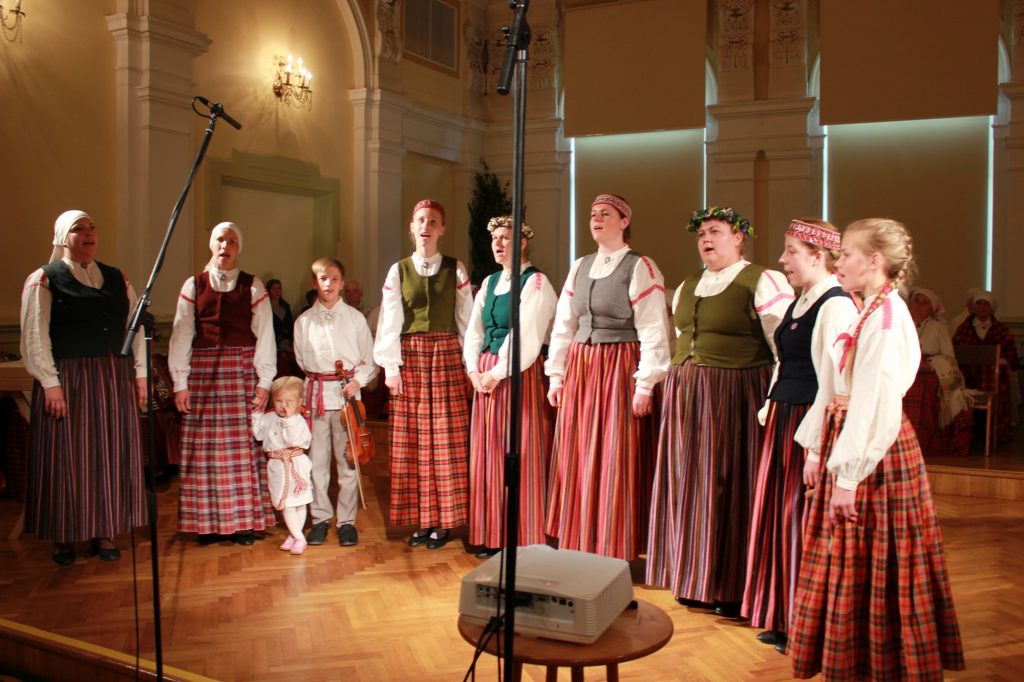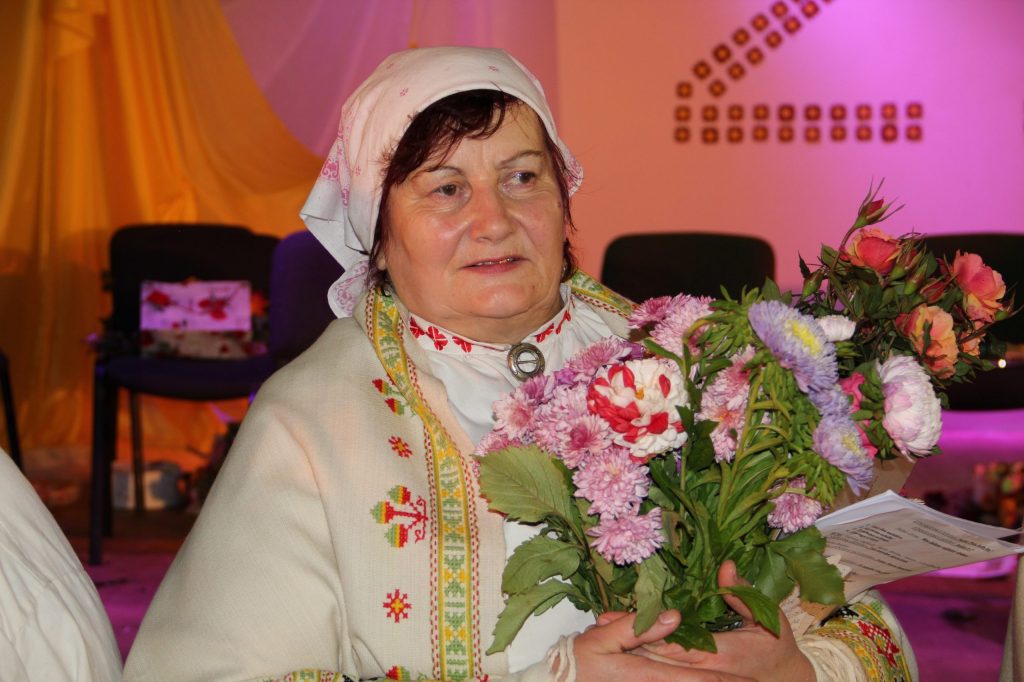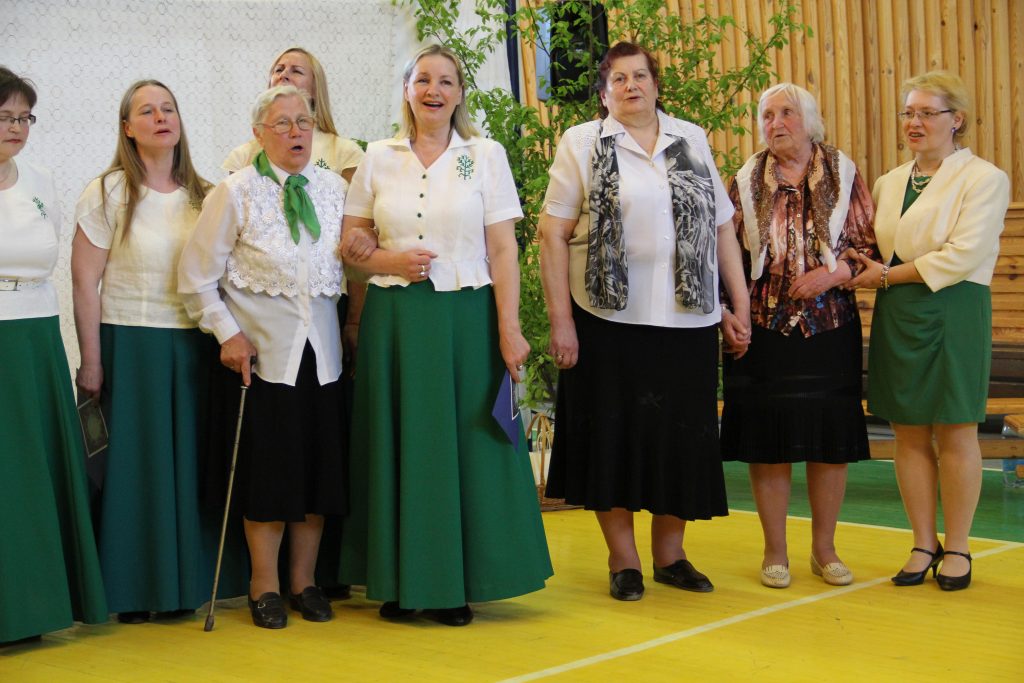Author:
Anda Beitane, Ruta Cibule
Oral traditions and their expressions, including language as a vehicle of intangible cultural heritage
Title
Singing with Pusbolss (2017)
Dzīduošona ar pusbolsu, dzīduošona ar pusbaļsi, klīgšona (izklīgšona) iz pusbaļša
Geography
Northern Latgale: Šķilbēni, Mednevo, Baltinava, Briezuciema, and Vectilža parish.
Singing with "pusbolss” has been able to survive and is still practised, thanks to the activities of ethnographic ensembles. Folklore groups, in this case, can be considered as an equivalent to a community, which, of course, does not exclude the existence of the tradition within the broader local community, extending beyond the boundaries of ensemble activities.
Folklore groups practising "dzīduošonu ar pusbolsu"
1. Skilbeni Etnographic Ensemble
2. Upite Etnographic Ensemble
3. Folklore Group "Upīte"
4. Folklore Group "Rekavas dzintars"
5. Baltinava Etnographic Ensemble
6. Briezuciems Etnographic Ensemble
7. Medneva Etnographic Ensemble
8. Medneva Folklore Group "Egle"
9. Vectilza Folklore Group "Saime"
Importance in Community Life
.
Activities
Singing with "pusbolss" is a specific type of multilingual singing traditionally associated with the parishes of North Latgale that border Russia – Skilbeni, Baltinava, Briezuciems, and Vilaka parish, namely the former territory of Abrene county.
It is polyphonic singing, where the melody is performed together with one or (occasionally) several supporting lower voices, as well as the special characteristic of this type of singing - the upper supporting voice performed as a solo by one singer, which in the local tradition is called "pusbolsa" (half-voice). The term "pusbolss" is understood as half of "bolss" (Northern Latgale singers refer to several of their songs as "bolsi").
This means that the “pusbolss” starts to play in the second half of “bolss”, or at least not from the beginning.
The narrator Anna Scemelinska commented on the name: “Pusbolss tuopiec, ka viņa [respectivelly, the upper supporting voice artist.” – B.] vīna pate dzīd pa augšu.”
In folk terminology, the names of other voices are also found: “Pī myusīm senuok dzīdova trijūs bolsūs: pirmīs bolss, ūtrīs bolss, saceja, i pusbolss" (Anna Scemelinska).
The narrators also explain how to sing the “pusbolss” correctly: “Up. You have to bring it up” adding that “the pusbolss" is only sung by one” (Stefanija Matisane).
Not every singer could perform this voice. Typically, one with a strong and loud voice was chosen. The performance of the upper supporting voice is referred to as "kliegšana" (shouting).
For example, Rozalija Slisane, from Skilbeni, says of this type of singing: Juoizklīdz tuo – iz pusbaļša [..] vot, vīnai juoizklīdz” but in another case, the same narrator warns other singers: “augši naīsuoc, navaries iz pusbaļša izklīgt”.
The narrator mentions that there are specific songs where the "pusbolss" is sung because, as noted by Anna Scemelinska, "not all songs have a pusbolss. Only select songs have it." (Beitāne 2009: 115-116).
Inheritance and transmission
Singing with "pusbolss" is one of the characteristics of traditional singing in Northern Latgale, which is primarily inherited and practiced by contemporary ethnographic ensembles and folklore groups. However, there are also cases where younger (middle) generations of singers from local communities strive to learn and practice this singing skill.
History
The name "dzīduošona ar pusbolsu" and also the type of singing did not originate in modern times.
Anna Scemelinska says: "As far as I can remember, it has always been there." All the narrators share that their mothers and grandmothers have used it.
This makes it possible to claim that multilingualism with the upper supporting voice in North Latgale has existed for more than 100 years. Empirical facts, which would give an immediate indication of the existence of this type of multilingualism in ancient times, have not been found, but it doesn't rule out the possibility that this tradition was also known in the past. (Beitane 2009: 116)
The researchers of Northern Latgale discovered and identified "dzīduošonu ar pusbolsu" only in the late 20th century, which was followed by systematic documentation and research.
These activities greatly emphasized the practice of the respective singing style within the activities of ethnographic ensembles.
However, even more, emphasis was placed on it through collaboration between local cultural workers and researchers in implementing projects aimed at promoting education and activities related to intangible cultural heritage.
With the generational shift, the number of masters of "pusbolss" singing has significantly decreased. However, there are still several outstanding "pusbolss" singers, and their numbers also tend to increase among the younger generation.
Masters
Excellent and good singers of "pusbolss” are found in several regions of North Latgale:
1. Helena Slisane, Baltinava
2. Evija Locmele, Rekova and Riga
3. Elita Buksa, Vilaka municipality, Skilbeni parish
4. Inita Raginska, Vilaka municipality, Medneva parish
5. Inara Sokirka, Vilaka municipality, Medneva parish
6. Marija Supe, Vilaka municipality, Skilbeni parish
7. Livija Supe, Vilaka municipality, Skilbeni parish
8. Santa Matisane, Vilaka municipality, Skilbeni parish
9. Kate Slisane, Vilaka municipality, Skilbeni parish
10. Silvija Babane, Viļaka municipality, Skilbeni parish
11. Natalija Smuska, Vilaka municipality, Medneva parish
12. Elija Logina, Baltinava parish
13. Maruta Locmele, Balvi municipality, Briezuciems parish
14. Inese Cibule, Vilaka municipality, Skilbeni parish
Institutions and Organizations
Centre for Intangible Cultural Heritage "Upīte"
The organization "Upītes jauniešu folkloras kopa"
The Medneva Parish Folk House
Skilbeni Parish Cultural Centre "Rekova"
Baltinava District Culture House
Baltinava Secondary School
Briezuciems Parish Folk House
Vectilza Parish Sports and Cultural Centre
Viduci Primary School
Strengthening the Tradition
Although a virus took over the world, much was done. In particular:
• The organization "Upītes jauniešu folkloras kopa" in collaboration with the Centre for Intangible Cultural Heritage "Upīte", created a video series “Meklējam meistaru”, detailing and showing how to train children in singing pusbolss (https://www.youtube.com/watch?v=gnSVlIeUgNw, https://www.upite.lv/meklejam-meistaru/params/post/3931459/meklejam-meistaru-4raidejums);
• The Intangible Cultural Heritage Centre “Upīte”, in collaboration with Ruta Cibule and the JIRMV traditional unit students, carried out field studies in the summer of 2020, interviewing the wives of the women's ethnographic ensemble.
• Intangible Cultural Heritage festival “Gūdi”, was created, where the values of Northern Latgale included in the list of intangible culture are celebrated, with special emphasis on singing in pusbolss. “Gūdi” took place in 2019 and 2021, curated by Andris Slišans, and these festivals will be held every year after if the situation in the country allows for it.
• Thanks to the long-standing interest of ethnomusicologists in the traditional values of North Latgale, in Anda Beitane's ambitious publication, which is intended for the European audience, “Notes from Latvia” Multipart Music in the Field" is rich in the northern Latgale nonmaterial culture.
• Texts from Anda Beitane and Ruta Cibule in the book “Nemateriālais kultūras mantojums Latvijā - Nacionālais saraksts” about the traditions of singing in pusbolss in Balvi, Baltinava, Rugja and Vilaka (20-25 p) parishes, published by Latvia's National Cultural Centre, 2019;
• In 2018, the director of the National Cultural Centre Signe Pujate received the Latgalian cultural year award “Boņuks” for the promotion of Latgalian culture in Latvia and the world – “Latgaliskūs vierteibu īkļaušona Nacionālajā Namaterialuos kulturys montuojuma sarokstā”.
• Beitāne, Anda. “Adapting the Parts: An Experiment as an Analysis Tool.” Ardian Ahmedaja (ed.). Shaping Sounds and Values: Multipart Music as a Means of Social and Cultural Interaction. CD-ROM with 27 audiovisual examples included. A publication of the Jāzeps Vītols Latvian Academy of Music. Riga: Musica Baltica, 2021: 35-57, ISBN 978-9984-588-67-4.
• Booklet and double disk “Notes from Latvia” presentation concert at the European Voice 5 in Vienna's Music and Performing Arts University on March 21, 2018. In which pusbolss singing was also performed and presented under the leadership of Anda Beitane.
More and more people are being introduced to singing with half a voice. Value is carried at global level, recognised and valued. Internationally in ethnomusicology, there is a recognisable name among multitudes researchers - half a bole without translating into other languages. There is the involvement of young singers – the change of generations, for example, in the river, the half-voice of the event “Goodi” was raised by one-and-a-half-hundred-year-old Jacob Slisans. COVID-19 affected the inheritance of the tradition. Banning gatherings is not good for half-voiced singing because a strong foundation is needed and can only be provided by meeting and syncing in a group of several people. Therefore, alternative activities were created on the Internet, which could be followed by learning more about this style of singing (https://www.youtube.com/watch?v=gnSVlIeUgNw, https://www.upite.lv/meklejam-meistaru/params/post/3931459/meklejam-meistaru-4raidejums).
The Balvi municipality was willing to participate in the provision of support for documentation and research. This is reflected in the transport provision for local journeys, accommodations, and catering provisions, sharing the information base needed for the preparation of research, as well as ensuring a small remuneration for the managers of ethnographic ensembles and folklore groups.
The National Cultural Capital Foundation has supported several projects implemented by the organisation “Upītes jauniešu kopa”. This funding created a master workshop on the Internet (https://www.youtube.com/watch?v=gnSVlIeUgNw un https://www.upite.lv/meklejam-meistaru/params/post/3931459/meklejam-meistaru-4raidejums), where it is possible to learn to sing pusbolss.
Continuity/Development
Over the next 5 years:
1. The Balvi municipality museum and cultural administration in collaboration with the Intangible Cultural Heritage Centre “Upīte” will continue and support the research done by the Latvian Music Academy researchers, as well as initiate new co-operation with the Latvian Folklore Repository of the Latvian University Literature, Folklore and Art Institute;
2. Methodist Kate Slisane of the Intangible Cultural Heritage Center "Upīte" of the Balvi region and Ruta Cibule, director of the Balvi Central Library, will investigate how the conditions of Covid-19 affected the dynamics of traditional events. Specifically:
2.1. ascertain how many bearers of tradition have gone down the path of eternity, how many continue to be active;
2.2. ensure and summarise how often and in which formats the inheritance activity has been restricted in the context of communication.
3. The methodist Kate Slisane from the Balvi Intangible Cultural Heritage Centre “Upīte” and the director of the Balvi Central Library, Ruta Cibule, will perform elementary audits, identifying the already known value carriers, as well as study whether there is a formation of a new generation;
4. The Balvi municipality museum, the Balvi cultural administration, the organisation "Upītes jauniešu folkloras kopa" and the Intangible Cultural Heritage Centre “Upīte” will continue recording songs sung in pusbolss by living wives who are still able of singing it, and this material will be transferred to the archives of the Intangible Cultural Heritage Centre “Upīte” to be used for the acquisition and analysis of pusbolss through recordings;
5. Inviting Music Academy educators, students and local storytellers to master workshops will be continued and promoted in order to better understand the essence of pusbolss and develop mastery.
1. in cooperation with cultural institutions, the Balvi municipality cultural administration will continue to pay salaries to the leaders of ethnographic ensembles and folklore groups. Thus their task will be to maintain the continuity of the activities of ensembles and folklore groups, focusing on the development of pusbolss singing and inheritance in younger generations.
2. The Intangible Cultural Heritage Centre “Upīte” will complete the digitisation of Ontons Slisans records and create a structured catalogue, where one of the sections will be songs in pusbolss, so that it will be easy to use in educating the younger generation, as well as research.
3. The Balvi municipality museum will carry out educational activities and events, inviting people who have been historic witnesses of pusbolss, creating quizzes, master workshops, or story evenings, involving the youth of Balvi municipality schools.
The objectives of these activities:
• Maintain as to not lose
• Promote to attract new people.
• Study and document to avoid shallowness.
• Not to interfere, but to be there so as not to distort or degrade.
Threats to the Tradition
The potential threat is linked to the change of generations and the dramatic decline in population.
Applicant
Balvi Municipality, Reg. No. 90009115622
Photo Gallery
Audio Materials
Video Materials
Publications
Beitane, Anda. (2012). “Multipart Singing in Northern Latgale: Dynamics of Tradition in the Late 20th – Early 21st Century”. In RES MUSICA, Nr. 4/ 2012, 125–143, ISSN 1736-8553.
Beitane, Anda. (2009). Vēlīnās izcelsmes vokālā daudzbalsība latviešu tradicionālajā mūzikā (Vocal polyphony of late origin in Latvian traditional music). Riga: LULFMI.
Beitane, Anda. (2008). Medņevas dziedātājas (The singers of Medneva). Riga: LULFMI.
Beitane, Anda. (2006). “Tradicionālā dziedāšana Ziemeļlatgalē: konteksti, personības, varianti.” (Traditional singing in North Latgale: contexts, personalities, variants). Coll. Letonica. No. 14. Riga: LULFMI.
Beitane, Anda. (2005). “Vokālā daudzbalsība latviešu tradicionālajā mūzikā: tradīcija un jaunrade.” (Vocal pluralism in Latvian traditional music: tradition and creativity). Coll. Letonica. No. 13. Riga: LULFMI.
Beitane, Anda. (2004). “Ziemeļlatgales teicēji un viņu loma latviešu tradicionālās kultūras mūsdienu procesos.” (North Latgale speakers and their role in the modern processes of Latvian traditional culture) Coll. Letonica. No. 11. Riga: LULFMI.
Beitane, Anda. (1996). Vokālā daudzbalsība ar augšējo pavadbalsi Šķilbēnu pagastā. (Vocal polyphony with upper accompanying voice in the Skilbeni parish). Master's Thesis. Riga: JVLMA.
Websites
http://www.balvurcb.lv/kb/ - In the section that lists personalities/folklore collectors, speakers, and performers, you can find information on the pusbolss masters mentioned in the application. In the section that covers projects for preservation of intangible cultural heritage, you can find information, including video materials, about developments related to the preservation of the element. In the section that covers collectives and events/ethnographic and folklore ensembles – you can find information about the groups mentioned in the application that practice and preserve the element mentioned in the application







